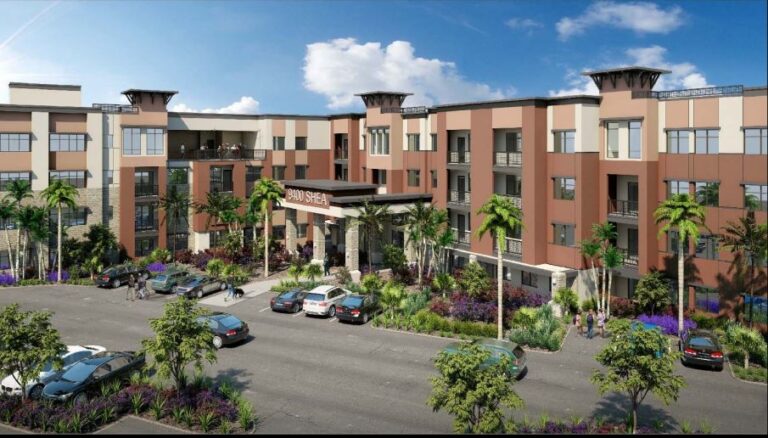By Roland Murphy for AZBEX
In our last issue, we looked at how development fatigue and resistance to the current pace of change in the Valley are harming housing affordability and putting the area economy at risk.
Today, let’s look at another trend that poses even greater threats: Organized resistance groups.
While nearly every development proposal meets with some degree of resistance from a percentage of area residents worried about traffic, density, building heights and the omnipresent “impacts to neighborhood character,” it is (so far) only an unlucky few who encounter organized resistance groups.
In 2019 the National Apartment Association conducted a survey seeking to find how difficult it was to build new apartment developments in 58 major markets across the U.S. It then published the “Barriers to Apartment Construction Index.” Among the criteria were:
- Community Involvement,
- Approval Timelines, and
- Political Complexity.
Metro Phoenix was 28th out of the markets examined. The two biggest challenges at the time were Land Availability and Infrastructure Constraints. The three criteria noted above, however, all scored higher than the index midpoint.
I contacted NAA on November 29th to ask when an updated survey is expected. The Association representative who replied to my email said he would check, but as of December 2nd there has been no answer. While Land Availability and Infrastructure Constraints are almost certain to remain significant barriers, I would be willing to bet the three criteria in the noted bullets points have all moved up as well.
The Problem is Getting Noticed, but Obvious Solutions Pose Challenges
The Arizona Republic is the staid and stolid vieille grande dame of Arizona news. It’s also about as nimble and responsive to change as an ore freighter in heavy seas. Its real estate coverage maintains a pre-Great Recession near obsession with single-family, and commercial development – including multifamily – is rarely discussed.
I say this not to bash an Arizona journalistic institution but to make it clear that by the time the Republic takes note of a trend and assigns one of its most senior staff writers to report on it, you can be certain it is an actual, deeply entrenched trend rather than a fly-by-night fad or passing issue.
So when Catherine Reagor, the Republic’s primary real estate reporter, does an article on the affordability crunch, NIMBYism and cities’ suicidal impulses regarding development, you can be certain that pot has been simmering for a good long time.
In her article, Reagor pointed out the Arizona Housing Authority has determined a statewide need of more than 270,000 new living units with rents and home prices less than the current rates to avoid a crisis. She also pointed out several of the factors making constructing those new units increasingly difficult, with development opposition ranking high on the list.
In writing about affordable housing developer Dominium’s efforts in Surprise, she cited another article in which Mayor Skip Hall called the opposition unlike anything he had ever seen.
Despite what opponents may claim, density is key in making the most efficient use of infrastructure and in generating the most revenue for cities. She compared two similarly sized locations in north Phoenix – one a 38-home single-family development, the other a 79-townhome community. Infrastructure burdens are much higher for the single-family homes, but they generate only $170K in annual property taxes, while the townhome development makes more efficient use and generates $320K in taxes.
Unfortunately, Arizona in general and the Valley in particular are still languishing under an outdated collection of zoning, entitlement and land use models. Zoning is still heavily tilted toward single-family.
According to Reagor’s article, the Maricopa Association of Governments reports 878,000 acres of land in Arizona zoned for or entitled for single-family, compared to just 17,000 for apartments.
In our previous article, we touched on the single-best cure for managing the difficulties the Phoenix area faces in getting new projects approved and developed. Land use attorney Nick Wood of Snell & Wilmer is a staunch proponent of reasonably structured planning, much of which is already in place, at least on paper. Wood recently used standards from the City of Phoenix’s General Plan and City of Scottsdale development plans for the Airpark area to win a recommendation of approval for an ambitious 14-story apartment tower at Scottsdale Road and Bell Road/Frank Lloyd Wright Boulevard.
As a reminder, the Phoenix General Plan recommends development, “Locate land uses with the greatest height and most intense uses within village cores, centers and corridors based on village character, land use needs and transportation system capacity.” That may seem an obvious and inherently logical starting point for urban planning, but keep in mind those standards are only applied consistently in two of Phoenix’s 15 Planning Villages, and some other cities do not have guidelines even that specific in place.
The key, most experts agree, to improving supply and minimizing impacts is in coherent and structured zoning. A 2019 study by economist Elliot D. Pollack recommended loosening government development restrictions and creating incentives for affordability. It’s a theme echoed by housing experts from the federal government to small towns to industry associations and economic development groups around the country. Modernizing zoning away from the 1950s-1980s white picket fence model still hobbling development would make approvals easier, lower neighborhood character disruptions and give opposition groups less room to maneuver in their battles against increased supply. It would instill some sanity and order into the current bedlam.
Unfortunately, carefully examining districts, revising zoning, assigning densities and pushing through the laws and ordinances that would codify reasoned development and cut zealots off at the knees is time-consuming, labor-intensive and carries a degree of political risk many officeholders and appointees have neither the availability nor the stomach to pursue.
A Snapshot of Opposition Targets
In the past several months, at least four planned additions to the housing supply have been stonewalled by organized opposition:
- District at 9400 Shea, 219 units, 92nd Street and Shea Boulevard, requests withdrawn with the intention to resubmit,
- 92 Ironwood, 310 units, 92nd Street and Shea Boulevard, continued to an undetermined future date,
- Greenbelt 88 (Lucky Plaza), 278 units, Hayden and Osborn roads, continued to February, and
- Waddell Crossing, 392 standard units, 221 senior units – both with affordable components – withdrawn indefinitely.
The District and 92 Ironwood projects were targeted for opposition by a group calling itself Protect Scottsdale. It was also opposed by some neighboring businesses, mostly due to concerns about access and egress increasing traffic and causing potential harm to medical office patients. Greenbelt 88 was targeted by Safeguard Scottsdale. The two groups’ opposition messaging overlaps, but it is not known to what extent, if any, their membership does.
It is worth noting the District, Ironwood and Greenbelt 88 projects had all received recommendations for approval from the Scottsdale Planning Commission but were expected to be voted down by City Council.
Waddell Crossing was opposed by a group called Voice of Surprise.
Each of these project proposals have undergone multiple revisions attempting to satisfy opponents’ concerns. Opposition groups have remained steadfast despite the efforts to accommodate them.
Each has also had major misinformation about their details and impacts included in social media posts and messages in opposition presented to approval bodies.
Another project, Homestead at Lehi Crossing, recently received a recommendation against approval from the Mesa Planning and Zoning Board. The proposal calls for 222 multifamily units near Loop 202 and McDowell Road in Mesa. As had happened in the Scottsdale cases, the opposition held fast despite several revisions to the original proposal resulting in lower building heights and several reductions in unit counts.
Opposition to the project did not appear to come from a named group, however, neighborhood homeowners associations may have filled in the role.
Astute readers probably picked up on the fact three of the five projects mentioned above are located in Scottsdale. The city seems to be ground zero at the moment for opposition groups and their supporters in local government. Fear not, the next, final, installment in this series will look at Scottsdale in detail.
For the moment, however, take a look at a comment from Courtney Gilstrap LeVinus, president of the Arizona Multihousing Association, quoted in a different Republic article recently. She pointed out that a cadre of activists oppose nearly all rental housing development in Scottsdale, which jeopardizes affordability.
She said, “Unfortunately, this NIMBY (Not In My Backyard) activism is creating a long-term threat to Scottsdale and the ability for people of all walks of life and all income levels to live there.” While the article focused on Scottsdale, it is, sadly, both a Valley-wide and nationwide trend.
Power in Numbers
For understandable reasons, organized groups have an easier time with officials than do individual citizens, regardless of whether those officials support the groups’ goals or not. Volume is a key factor, both in tone and numbers. Regarding tone, opponents tend to be much more vocal and impassioned than supporters. Supporters may see a given project as bringing a benefit to an area. Opponents often see the same project as a threat to their very way of life.
In terms of numbers, it is quite simply easier to meet or have a phone call with the representative of an organization that represents 100 people than it is to field 100 separate conversations. The fact that people bothered to spend the time and effort to create or join a group, sign petitions (even dubious online petitions) published by the group, or put other energy toward the issue as part of a unified effort also lends credibility beyond that of an individual caller or letter writer.
As I touched upon above, groups also have their own sociological power. Members are less likely to be persuaded by developer explanations or proposal adjustments than they would be if they were just individuals. In terms of psychological dynamics, the group becomes part of the individual’s identity. It is even theoretically possible that developer attempts to accommodate the group’s expressed desires could be construed at a primal level as threats to the group, itself, since resolving the issue would render the group no longer necessary.
The existence of a group also serves to quiet, perhaps even silence, residents who support projects. Whether or not opposition groups engage in direct intimidation, their very presence is intimidating. Individual supporters can feel quite alone when 100 of their neighbors are all publicly wearing the same colors. Supporters who chime in on Facebook, Nextdoor or other social media outlets are quickly blocked from group discussions after being shouted down in the virtual square. The passion level to defend a given project in the face of rabid and vitriolic opposition is, understandably, lacking in most people. That revitalized intersection might be nice, but it is not worth the equivalent of a modern day tarring and feathering for heresy.
There are also real political considerations officials must consider when there is an organization to contend with. In my 20-plus years of consulting with and volunteering with various anti-child abuse lobbying organizations and civil rights groups, I have learned the issue those groups represent is far less important to politicians than the fact that they represent a block of votes.
If a council member votes to approve a 300-unit contested apartment development, there is no guarantee that the residents will be voters and no reason to assume they will vote for the councilor in appreciation for getting their new home built. There is, however, a high probability opposition group leaders will remember the vote and press group members to support or oppose the councilor on the next ballot.

